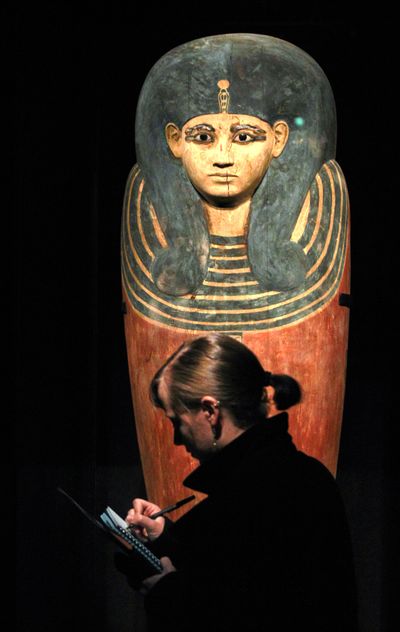Tut exhibit back in Seattle
Egypt’s antiquities minister hopes show is a huge draw

SEATTLE – It’s been more than 30 years since crowds of people from around the Pacific Northwest stood in long lines at Seattle Center to see King Tut, the boy king. The Pacific Science Center is hoping the pharaoh will generate the same kind of enthusiasm this year with a new exhibit that opened on Thursday.
But here’s some news for people who are hoping to meet the mummy who inspired one of the most famous “Saturday Night Live” skits of all time: You’ll have to fly to Egypt to see him. King Tut has never left his homeland.
The mummy is no longer kept inside his elaborate coffin, but he remains inside the tomb in the Valley of the Kings, according to the curator of this exhibit, David Silverman, an Egyptologist and University of Pennsylvania professor, who describes the country as a living museum.
King Tut has done little traveling since his death, but as Steve Martin sang: “He gave his life for tourism.”
That’s why Egypt’s Antiquities Minister Mohammed Ibrahim traveled to Seattle for the exhibit opening instead of staying home to vote in that country’s first democratic election.
“Today, history is being written again,” Ibrahim said at a press conference on Wednesday. “It’s a great day for us.”
Ibrahim told the Associated Press he didn’t get to vote in the election back home but felt it was worth the trade-off because he felt he could help his country more by promoting tourism.
He hopes the exhibit will inspire travel to Egypt, whose economy could use the kind of boost Seattle is likely to get from this exhibit.
“Please, we need your help. We need you to support our revolution. We need you to support our movement toward peace and democracy,” Ibrahim said.
He also wants a lot of people to see the Seattle exhibit because the eight host museums are sending more than $2 million back to Egypt to help build a new museum in Giza to house the King Tut artifacts and other statues and art from thousands of years of Egyptian history.
Objects that span and explain that same period of history are scheduled to be on display at the Pacific Science Center through Jan. 6, 2013 – from stone statues of Egyptian kings, their children and servants to beautiful jewelry and the mini coffin that held King Tut’s stomach.
The museum focuses on the history and culture of the time period but offers a little bit of science and some wonderfully gory pictures of Tut’s mummy just outside the exhibit and beyond the gift shop.
The items on display are just a sample of what was found inside King Tut’s tomb in the 1920s and just two repeats from the exhibit that came to Seattle in 1978.
To gain a better idea of the wealth of that discovery, which many have called the biggest archaeological find in history, you’ll need to make travel plans to visit Egypt in 2015. That’s when the traveling exhibit will be added to the objects that have never left Egypt in the new museum.
Small children may be bored in the dark, quiet spaces of the Pacific Science Center exhibit. But school-age kids will find some things to capture their attention, including a small coffin used to bury a royal cat and a video that teaches visitors how to read hieroglyphics.
Museum officials point out that school tours are all booked for this spring, but a few slots are still available in the fall.
Near the door leading out of the gift shop, don’t miss the two machines that will type your name in hieroglyphics for just one dollar. This last attraction may help parents who don’t want to spend money on any of the cool Egyptian headdresses, masks or magnets usher their kids toward the door.
The science center wants people to know there won’t be any long lines this time because they are selling timed tickets. The center already sold 90,000 tickets before the exhibit opened, and some time slots are already sold out. In 1978, more than 1.3 million people saw the King Tut exhibit in Seattle.